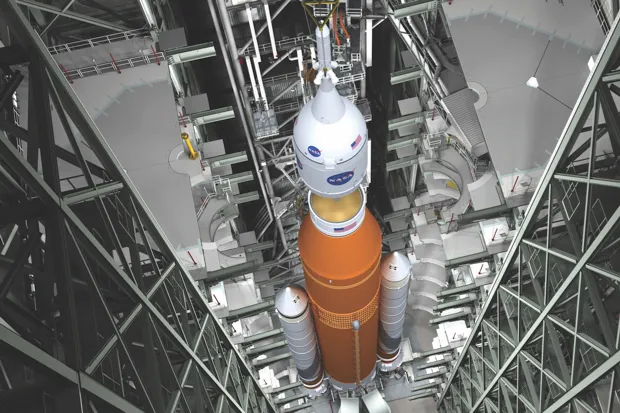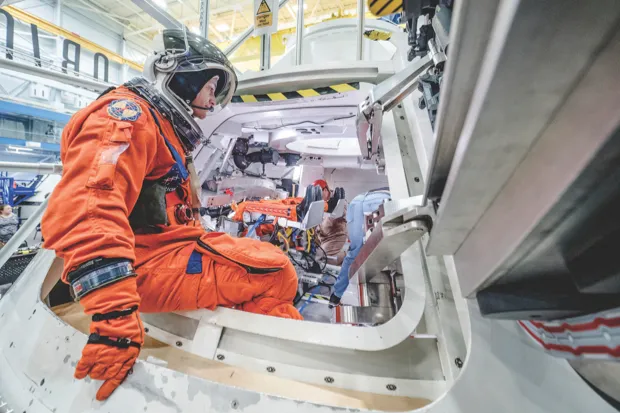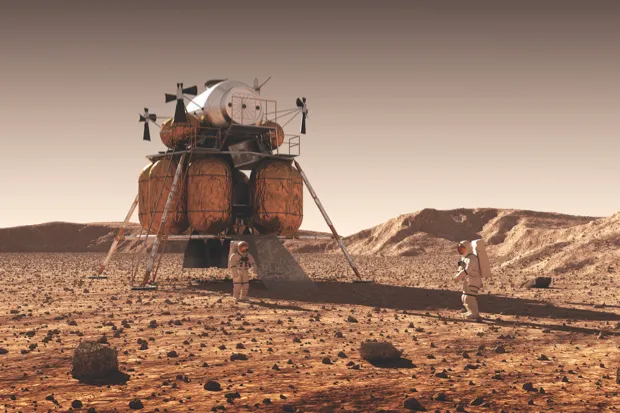A distance of 410,000km. That’s how far away astronauts will be when they’re living aboard a new space station that’s set to be built in orbit around the Moon. To put it in context, you could fit 30 Earth-sized planets across that distance.
Currently in development, the ‘Lunar Orbital Platform-Gateway’ will take humans further from Earth than ever before. Known as Gateway for short, and previously named Deep Space Gateway, the space station is being developed by NASA and other space agencies, including the European Space Agency (ESA) and Russia’s Roscosmos.
It will be a replacement for the International Space Station (ISS), which is celebrating 20 years in space this month. While the fate of the ISS hangs in the balance, one thing is certain – the White House has asked NASA to stop funding the ISS in 2025. Instead, the Trump administration wants the space agency to focus its efforts on returning to the Moon and then to Mars. And that’s where Gateway comes in.
“Gateway has been developed to take humans beyond low Earth orbit and out into the cosmos,” says Dr James Carpenter, an ESA scientist working on the new space station. “The idea is that it provides an infrastructure for future exploration, and somewhere we can learn how to live and work in deep space.” Whereas the ISS flies in low Earth orbit, just 400km (250 miles) above our heads, Gateway will be hundreds of thousands of kilometres away.
Gateway will make the surface of the Moon one short hop for astronauts, allowing them to explore like never before, and creating a new generation of Moonwalkers in the process. It’ll also enable a new wave of science experiments to probe some of the mysteries of deep space. In the longer term, it is hoped that Gateway will act as a service station for spacecraft taking astronauts to Mars and beyond.

But building a space station way out in lunar orbit is strewn with challenges. How do you lug tonnes of hardware all the way out to the Moon? How do you keep astronauts safe? Unlike those on the ISS, the astronauts aboard Gateway won’t be shielded from cosmic radiation by Earth’s magnetic field. And they can’t just be whisked back home if something goes wrong. Aboard the ISS, they can return in hours. The journey between Earth and the Moon takes days.
Size matters
Gateway will be different from the ISS. For starters, it will be much smaller. At 109m long and 73m wide, the ISS is slightly larger than an American football field. The main body of Gateway will be 30-35m long and 5m wide. For comparison, a typical London Underground carriage is around 17m long and 3m wide. And while the ISS is occupied by at least three astronauts 365 days a year, Gateway will be occupied by four crew members, but only for 30 days a year, due to the cost of getting astronauts there. The rest of the time, it won’t have a soul on board.
Those lucky enough to make it to Gateway will be in for one heck of a ride. On the space station’s most likely path around the Moon, astronauts will pass within 3,200km of the lunar surface. “Once a week, you would see the Moon very large beneath you,” says Jim Clark, an aerospace engineering PhD student, who works in a lab that conducts research on the design and controls of Gateway. “It would fill the view out of the window.” At the furthest point on its orbit, however, Gateway will be about 70,000km from the Moon and 410,000km from Earth. The two celestial bodies will be nothing but distant spheres: unprecedented isolation.

This far away, communications will be a huge challenge. If the same radio technology was used aboard Gateway as is used on the ISS, the data rate would be 1/160,000th that on the ISS. “This would only be useful for minimal status signals and possibly voice communication,” says Clark. If the astronauts wanted to transfer scientific data to Earth-bound researchers, or carry out video calls with their loved ones, they’d need a much speedier connection. One option is to move from radio to laser communication – something that NASA plans to trial on a commercial satellite next year.
Multi-purpose vehicle
A key feature of Gateway is that it won’t be stuck in one orbit: it’s been designed so that it can fly into different ones, depending on its mission. In other words, it’s a cross between a spacecraft and a space station.
Whereas the ISS uses chemical thrusters to give it the occasional boosts needed to keep it in orbit, Gateway will shift between orbits by using solar electric propulsion, a technology that uses energy from the Sun to power fuel-efficient thrusters. Other orbits proposed for Gateway include a tight orbit close to the lunar surface, and a larger orbit some 1.5 million kilometres out into space.
Gateway’s propulsion system will be the first of the station’s modules to be launched into space – as soon as 2022. NASA is expected to award the contract for this element to a private company next March. All of the station’s other components will be lifted into space by NASA’s new load-lugging rocket, the Space Launch System (SLS), capable of taking over 100 tonnes of hardware into low Earth orbit, including the Orion spacecraft (also currently in development). Once the Gateway modules and Orion are in space, Orion will transport the modules out to lunar orbit so that they can be linked together.

It’s also in Orion that astronauts will reach Gateway – a journey that’s likely to take around three days. Once they’re there, one of the biggest questions is how to keep them safe in the event of an emergency. The main solution will be to replicate essential technology in different parts of the space station, so the astronauts can move to another area if one piece of equipment gets damaged or broken. “So if that module has to be chopped off, don’t worry you have computer power on the other side, you have propulsion on the other side,” says Prof Mitchell Walker, an aerospace engineer at Georgia Tech College of Engineering in Atlanta, who’s not involved in the project. “You always want to be in a position where there is a duplicate of everything.” This would make a situation that requires an evacuation of the whole space station much less likely.
Moon lab
Then there’s the question of cosmic radiation in deep space. “The entire space station could be heavily armoured against radiation, but that carries a cost in fuel to get it there,” says Clark. “So they may choose to make just one section heavily armoured, to act as a storm shelter.” Thicker metal walls would act as a radiation barrier in this shelter. Astronauts might sleep in it overnight, or take refuge during periods of intense radiation, such as during a solar flare.
Studying this radiation will be a research priority on board Gateway, as it’s something we know surprisingly little about. “We know that cosmic radiation consists of solar wind, galactic cosmic rays and solar flares, but we don’t know the levels of each, and whether there are certain patterns in this radiation or whether it’s random,” says Dr Jennifer Ngo-Anh, who coordinates human, biological and physical science research for ESA and has been tasked with shaping Gateway’s research projects. What Gateway tells us about cosmic radiation will help scientists develop the protection needed for a trip to Mars and back. “If we want to do human exploration in deep space, radiation is currently one of the showstoppers,” says Ngo-Anh.
Both NASA and ESA have been asking scientists what kinds of experiments they’d like to run aboard Gateway. The Moon is a key target, especially since the confirmation of water ice on the lunar surface earlier this year. A big question is the exact origin of this water, as well as other ‘volatiles’ (substances with low boiling points) on the Moon, such as hydrogen sulphide and sulphur dioxide. Did they come from comets and asteroids, did they erupt from inside the Moon itself, or did they come from somewhere else entirely? “Answering this question could tell us about the origins of volatiles in the inner Solar System, and where the volatiles that enabled life on Earth came from,” says Carpenter.
Other experiments have been mooted, like analysing the dust that drifts in deep space – including the interstellar dust from other solar systems – as well as studying the interaction between the solar wind and Earth’s magnetic field. Whichever experiments are selected, they’ll have to be operated remotely, as Gateway will be uncrewed most of the time.

A priority for Gateway will be to act as a test bed for the technology required for missions to Mars. But not everyone is convinced that it will achieve this. “None of the enabling technology you would need to get to Mars would be accomplished or tested using Gateway,” says Terry Virts, a former NASA astronaut who spent 200 days aboard the ISS from 2014 to 2015. Virts says Gateway would not allow the development of a necessarily powerful propulsion system for getting to Mars, nor a nuclear energy system to power life support technology on the Martian surface. He says that the best way for astronauts to reach Mars would be aboard a high-speed craft, continually shuttling between Earth and the Red Planet, and that Gateway should be redesigned to do the same thing between the Earth and the Moon. “Let’s practise getting to the Moon in a way we are going to get to Mars,” he says.
Whether Gateway even happens at all is dependent on sufficient support and funding being provided by politicians into the future. Key to this will be ESA’s ministerial council meeting in late 2019 in Spain, where billions of euros of funding will be allocated to space projects. Developing the world’s most powerful rocket, the Space Launch System, is also proving problematic – a recent report by NASA’s own auditors criticised the rocket’s spiralling cost and delays. But for now at least, Gateway has momentum – a momentum that could take astronauts further than they’ve ever been before.
And there’s no denying that this would be a profound experience – particularly when the Earth and Moon are at their most distant. “The Moon would be about the size of a golf ball held at arm’s length, and the Earth a little smaller even than that,” says Clark. “So you wouldn’t feel much attachment to either one. This would be a point of view shared by nobody else in the Solar System.”
This is an extract from issue 329 of BBC Focus magazine.
Subscribe and get the full article delivered to your door, or download the BBC Focus app to read it on your smartphone or tablet. Find out more
Follow Science Focus onTwitter,Facebook, Instagramand Flipboard
